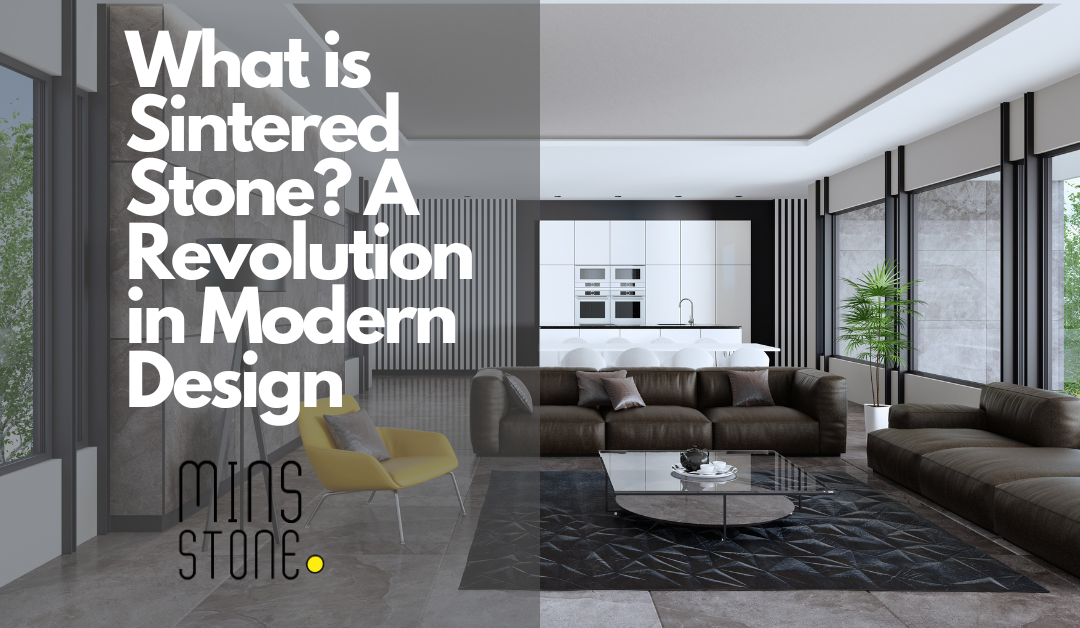What is Sintered Stone?
In today’s rapidly evolving world of interior design and architecture, materials that offer both aesthetic appeal and practical functionality are in high demand. One such material that has recently gained prominence is sintered stone. If you’re new to this term, you’re not alone. But fear not, because this blog post will unravel the mystery behind this innovative material.

Understanding Sintered Stone Malaysia
Sintered stone is a man-made material created from natural elements like stone particles, glass, and pigments. The mixture is subjected to extreme heat and pressure, mimicking the natural process of stone formation that occurs over thousands of years. You might also love to know the sintered stone vs quartz stone in this case.
The end product is a highly durable and aesthetically pleasing material that has found its place in numerous applications in our homes and offices.

Manufacturing Process
The manufacturing process is an integral part of what makes the sintered stone so unique. The raw materials, which primarily consist of minerals like quartz and feldspar, are first ground into a fine powder. This powder is then subjected to a process known as ‘sintering,’ where it’s exposed to temperatures exceeding 2,000 degrees Fahrenheit and immense pressure. This combination replicates the natural stone formation process, resulting in a material that is tough, durable, and non-porous.
Features and Benefits
The appeal of sintered stone largely comes from its exceptional features. Here are a few notable ones:
Durability:
Sintered stone is incredibly robust and resistant to scratches, stains, and UV rays, maintaining its beauty for an extended period.
When we speak about the durability of sintered stone, it’s a multifaceted attribute that speaks volumes about the material’s longevity and performance.
Firstly, sintered stone is exceptionally robust, a quality that derives from its manufacturing process. The extreme heat and pressure it’s subjected to fuse the natural elements, resulting in an incredibly hard and dense material. This hardness equates to a remarkable resistance to scratches. Whether it’s the accidental sliding of a kitchen utensil or the constant foot traffic in commercial spaces, sintered stone surfaces maintain their smooth, unblemished finish.
Stain resistance is another fantastic attribute of sintered stone. Thanks to its non-porous nature, it doesn’t absorb liquids. Spills from common household items like wine, coffee, or oil can be easily wiped away without leaving a trace. This feature is particularly appreciated in kitchens and bathrooms, where the potential for spills is higher.
Additionally, sintered stone is highly resistant to UV rays. Natural stones or other materials may fade or discolor when exposed to sunlight over time, but sintered stone retains its vibrant color and texture, even when used in outdoor applications. This UV resistance is a testament to the material’s stability and ensures that it maintains its beauty for years to come.
The combination of these qualities makes sintered stone an extremely durable material. It’s designed to withstand the rigors of daily life while maintaining its aesthetic appeal, truly standing the test of time. Whether for residential or commercial use, indoors or outdoors, sintered stone delivers unmatched durability, ensuring that your investment not only looks stunning but also lasts for an extended period.
Non-porosity:
Unlike natural stones that can absorb liquids and stain over time, sintered stone is non-porous, making it ideal for kitchen countertops, bathrooms, and other wet areas.
Non-porosity is a defining characteristic of sintered stone, distinguishing it from many other surface materials, particularly natural stones like marble and granite. This attribute significantly contributes to the functionality and practicality of sintered stone in various applications.
When a material is described as ‘non-porous,’ it essentially means it lacks tiny pores or spaces where liquids or gases could be absorbed. Natural stones, despite their beauty, are often porous to a certain degree, allowing substances to penetrate their surface. This porosity can lead to staining and discoloration, and in some cases, can even encourage bacterial growth, making the surface unsanitary over time.
On the other hand, sintered stone is non-porous. Its manufacturing process leaves no room for microscopic pores, thereby not giving any opportunity for water, oils, or other staining substances to penetrate its surface. This characteristic makes it highly resistant to staining, even from the most pigmented substances like red wine or beetroot juice. No matter what you spill, a simple wipe-down is usually enough to restore the surface to its original state.
The non-porous nature of sintered stone also makes it hygienic. Bacteria, molds, and other microorganisms can’t take root in the material, making it a safe choice for surfaces where cleanliness is paramount, such as kitchen countertops, bathroom vanities, or even medical facilities.
Furthermore, this feature makes sintered stone a great choice for wet areas. In bathrooms, around swimming pools, or in outdoor kitchens, sintered stone resists moisture absorption, preventing any damage or warping that can occur with other materials.
In conclusion, the non-porosity of sintered stone is not just a technical detail. It’s a game-changer that makes this material an ideal choice for numerous applications, offering a clean, durable, and low-maintenance surface solution.
Heat Resistance:
Thanks to the high-temperature sintering process, this material can withstand heat, making it an excellent choice for outdoor applications and fireplace surrounds.
Heat resistance is a critical factor when considering materials for various applications, particularly those exposed to high temperatures. Sintered stone, thanks to its unique manufacturing process, boasts an impressive heat resistance that sets it apart in the market.
The high-temperature sintering process, which involves exposing the raw materials to temperatures exceeding 2,000 degrees Fahrenheit, fundamentally alters the structure of the material. This transformation imbues sintered stone with an exceptional ability to withstand high temperatures without compromising its structural integrity or aesthetic appeal.
This heat resistance means that hot pots and pans can be placed directly onto sintered stone countertops without the risk of damaging the surface or causing discoloration. This feature is incredibly valuable in kitchen environments where the material might frequently come into contact with hot cookware.
Moreover, this characteristic makes sintered stone an excellent choice for fireplace surrounds. The material can endure the intense heat of a fire without cracking, warping, or discoloring, providing a safe and stylish solution for this application.
Outdoor applications are another area where the heat resistance of sintered stone shines. Whether it’s a hot summer day or the surface is used in an outdoor kitchen setting, the material maintains its color, texture, and integrity, even when exposed to extreme temperatures.
Additionally, sintered stone’s resistance to thermal shock, the damage that can occur from sudden temperature changes, further underscores its suitability for both indoor and outdoor applications. It can seamlessly transition between cold winters and hot summers without showing signs of distress.
In essence, the heat resistance of sintered stone provides a wealth of design possibilities. It ensures that, irrespective of the environment or application, the material will maintain its stunning appearance and high performance, offering a safe, practical, and beautiful solution for any heat-intensive setting.
Versatility:
Sintered stone can be manufactured in a variety of colors, textures, and finishes, mimicking the appearance of marble, granite, wood, or concrete, offering designers a versatile palette to work with.
One of the most compelling aspects of sintered stone is its versatility. This characteristic makes it an incredibly adaptable material, capable of meeting a wide range of aesthetic preferences and design requirements.
Sintered stone can be manufactured in an array of colors, from natural, earthy tones to vibrant hues, allowing it to complement virtually any design palette. This color versatility makes it an excellent choice for various settings, whether you’re aiming for a minimalist, modern vibe with crisp whites and grays, or a warm, rustic feel with rich browns and beiges.
Moreover, sintered stone isn’t limited to a single texture. It can mimic the veining of luxurious marble, the speckles of granite, the grain of wood, or the industrial feel of concrete. This ability to replicate other materials with such authenticity means you can enjoy the aesthetic appeal of these materials without their associated drawbacks. For instance, you can achieve the look of marble without worrying about staining or etching, or enjoy the appearance of wood without concerns about warping or rotting.
The finishes of sintered stone add another layer to its versatility. Depending on your preference, you can opt for a glossy finish that reflects light and adds a touch of glamour, a matte finish for a more understated and contemporary look, or a textured finish that adds depth and interest to your space.
Furthermore, sintered stone can be fabricated into different thicknesses, making it suitable for a variety of applications, from hefty kitchen countertops to sleek wall panels.
Beyond its aesthetic versatility, sintered stone is also structurally versatile. Its durability, non-porosity, and heat resistance make it suitable for indoor and outdoor use, in both residential and commercial settings.
In conclusion, the versatility of sintered stone offers boundless design possibilities. Whether you’re a homeowner seeking to refresh your space or a designer looking for the perfect material to realize your vision, sintered stone provides an adaptable, durable, and aesthetically pleasing solution. It truly is a testament to how far man-made materials have come, offering unparalleled versatility without sacrificing performance or beauty.
Interior Design Application of Sintered Stone
With its many benefits, sintered stone can be used in a variety of applications, including:
Kitchen Countertops: Given its resistance to stains, scratches, and heat, it’s an ideal material for kitchen countertops.

Flooring: Its high durability makes it perfect for high-traffic areas like hallways and living rooms.

Bathroom Surfaces: Its non-porous nature and resistance to moisture make it suitable for bathroom vanities, shower walls, and tub surrounds.

Exterior Cladding: Sintered stone can withstand harsh weather conditions, making it a fantastic choice for exterior cladding and outdoor kitchen areas.
Sintered stone is undoubtedly one of the most innovative materials in the market today, offering a perfect blend of beauty, functionality, and versatility. Whether you’re a homeowner, an architect, or an interior designer, this material provides an opportunity to create stunning designs that stand the test of time. As more people discover the benefits of sintered stone, it’s likely to become an even more popular choice in the world of design and architecture.

Conclusion – Unlocking the Potential of Sintered Stone
In conclusion, sintered stone is a game-changer in the world of design and architecture. With its exceptional durability, non-porosity, heat resistance, and aesthetic versatility, it presents a compelling choice for those seeking a balance of functionality and beauty in their design elements.
The innovative manufacturing process of sintered stone not only mimics nature but also enhances it, offering a material that outperforms many natural counterparts. Its resistance to scratches, stains, and UV rays guarantees longevity, while its non-porosity ensures it remains hygienic and easy to maintain. Its impressive heat resistance makes it suitable for a variety of applications, even those exposed to high temperatures.
But perhaps the most exciting aspect of sintered stone is its versatility. With the ability to emulate the look of marble, granite, wood, or concrete in a spectrum of colors and finishes, it provides an expansive palette for designers and homeowners alike.
Whether you’re renovating your kitchen, designing a new bathroom, or planning a commercial project, sintered stone offers an attractive, durable, and versatile solution that meets the demands of modern living. If you’re ready to explore the boundless potential of this material, sintered stone may just be the key to unlocking your design dreams.


